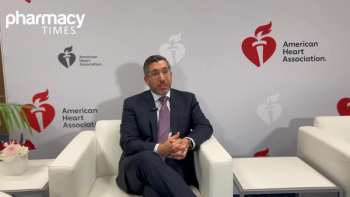
Pharmacy Practice in Focus: Oncology
- June 2021
- Volume 3
- Issue 3
What Pharmacists Should Know About Endometrial Cancer
In the United States, endometrial cancer is the most common cancer of female reproductive organs.
Endometrial cancer is a type of uterine cancer that begins in the layer of cells forming the lining, or endometrium, of the uterus. Endometrial cancer is often detected early because it causes abnormal bleeding.1
Statistics
In the United States, endometrial cancer is the most common cancer of female reproductive organs. Uterine sarcomas account for up to 10% of uterine body cancers, including endometrial cancers and uterine sarcomas. Therefore, the numbers for endometrial cancer are slightly lower than these estimates.
According to the American Cancer Society, in the United States, in 20212:
- Approximately 66,570 new cases of cancer of the uterine body or corpus will be diagnosed.
- About 12,940 deaths will occur due to cancers of the uterus.
Endometrial cancer is found mostly in postmenopausal women, usually 45 years and older. The average age at endometrial cancer diagnosis is 60 years.2
Survival Rates
Survival rates are based on women who were diagnosed with endometrial cancer between 2010 and 2016.3
- Women with localized endometrial cancer (confined to the uterus) have a 95% 5-year relative survival rate.
- Women with regional endometrial cancer (cancer has spread to nearby structures or lymph nodes) have a 69% 5-year relative survival rate.
- Women with distant endometrial cancer (cancer has spread to distant places like the lungs, liver, or bones) have a 17% 5-year relative survival rate.
- All surveillance, epidemiology and end result stages combined provide an 81% 5-year relative survival rate.
- These numbers are based on women who received a diagnosis and were treated at least 5 years prior. Because treatments improve over time, the outlook may be better than these numbers show. Other factors, such as age and overall health, also can affect the outlook.3
Risk Factors
Risk factors do not always lead to endometrial cancer, and if a woman has endometrial cancer, it is not always possible to identify which, if any, risk factors, caused the cancer.
Risk factors include as follows4:
- obesity—endometrial cancer is twice as common in overweight women and 3 times as common in obese women,
- hormonal factors—a shift in the balance of hormones to more estrogen, including the following:
- estrogen-replacement therapy (without progesterone) increases the risk of endometrial cancer
- total lifetime number of menstrual cycles: more cycles equal greater risk
- use of tamoxifen
- ovarian tumor (granulosa cell tumor)
- polycystic ovarian syndrome
- age—the risk increases as women get older,
- diet and exercise—a high-fat diet increases the risk; physical activity lowers the risk,
- type 2 diabetes,
- family history—close relatives with endometrial or colorectal cancer,
- history of breast or ovarian cancer,
- history of endometrial hyperplasia,
- prior radiation therapy to the pelvis to treat another cancer.
Conversely, birth control pills, nonhormonal intra-uterine devices, and pregnancy lower the risk.
Signs and Symptoms
Most women with endometrial cancer (over 90%) have abnormal vaginal bleeding. The bleeding may appear as watery, pink, or white discharge. Women who still menstruate may have heavy bleeding between periods. Other symptoms may include pain or difficulty urinating and pain during sexual intercourse. Pelvic pain and unexplained weight loss can be symptoms of later stages of endometrial cancer. Early detection significantly increases the chances of survival.5
Diagnosis
The diagnosis of endometrial cancer involves a physical exam, including a pelvic exam and other imaging tests like computed tomography, magnetic resonance imaging, and positron emission tomography imaging.6
If it looks like endometrial cancer is present, an endometrial biopsy may be taken. A hysteroscopy may also be performed. Some patients also require dilation and curettage.6
Staging and Types of Endometrial Cancer
According to the International Federation of Gynecology and Obstetrics, endometrial cancer is classified into 4 stages7:
- stage I: cancer is confined to the uterus. Almost 70% of endometrial cancer diagnoses occur in this stage,
- stage II: cancer has spread to the cervix,
- stage II: cancer has spread to the vagina, ovaries, and/or lymph nodes, and
- stage IV: cancer has spread to the bladder or rectum, or farther away organs such as the lungs or bones.
The most common type of endometrial cancer is endometrioid adenocarcinoma. This type accounts for up to 75% of all uterine cancers, is usually detected early, and has a high cure rate.8
About 10% of uterine cancers are serous adenocarcinomas, which are more likely to spread. Other, less common types include adenosquamous carcinoma and carcinomasarcoma.8
Treatments
Endometrial cancer treatment options include surgery, radiation therapy, chemotherapy, and other drug therapies. A treatment plan is based on the stage and type of endometrial cancer, as well as age, overall health, and if the patient wants to bear children.9
Surgery
Often, surgery is the main treatment for endometrial cancer.10 When detected early, surgery often cures the cancer.1 Surgery usually consists of the following10:
- hysterectomy—removing the uterus and cervix. This causes infertility,
- Salpingo-oophorectomy—removing the ovaries and fallopian tubes. This causes menopause if the woman was premenopausal,
- Removal of pelvic and para-aortic lymph nodes—nodes are tested for cancer cells to help determine the stage of endometrial cancer.
Other procedures may be necessary, depending on the cancer’s spread.10
Radiation is often used several weeks after surgery to kill any remaining cancer cells in the area. Sometimes, radiation is done before surgery to help shrink the tumor. There are different types of radiation that may be used separately or together.11
Chemotherapy
Chemotherapy is often used when the cancer has spread and surgery cannot be done, for cancers that are growing and spreading quickly, or cancers that have recurred. Chemotherapy is not used for stages I and II of endometrial cancer.
Usually, a combination of chemotherapy drugs is used in cycles. Common drugs include paclitaxel, carboplatin, doxorubicin, cisplatin, or docetaxel. The most common combinations are carboplatin and paclitaxel, or cisplatin and doxorubicin.12
Various types and stages of cancers are treated with different regimens, some involving radiation in between cycles or even chemotherapy and radiation together.12
Common adverse effects of chemotherapy include nausea, vomiting, appetite loss, mouth and vaginal sores, and hair loss. Low white blood cell counts increase the risk of infection, low platelet counts increase the risk of bleeding and bruising, and low red blood cell counts can cause fatigue and shortness of breath.12
Other adverse effects can occur with various chemotherapy drugs, such as the following12:
- doxorubicin can cause heart muscle damage,
- cisplatin can cause kidney and nerve damage, and
- paclitaxel can cause nerve damage.
Hormone Therapy
Hormone therapy uses hormones or hormone-blocking drugs to treat cancer. It is usually used for cancers in stages III or IV, or cancers that have recurred and usually used along with chemotherapy. The most common hormone therapy drugs are progestins (medroxyprogesterone or megestrol), but other drugs such as tamoxifen, LHRH agonists, or aromatase inhibitors may be used.13
Targeted therapy
Targeted therapy uses drugs that target changes in cancer cells and is still new in treating endometrial cancer. These drugs mostly treat high-risk cancers and cancers that have metastasized or recurred.14
Targeted therapy drugs include the following:
- Lenvatinib (Lenvima; Eisai Inc) is a kinase inhibitor often used along with immunotherapy drug pembrolizumab (Keytruda; Merck), given as a once-daily capsule.14
- Bevacizumab (Avastin; Genentech) is an angiogenesis inhibitor, given alone or with chemotherapy as an intravenous (IV) infusion every 2 to 3 weeks.14
- Everolimus (Afinitor; Novartis) is an mammalian target of rapamycin (mTOR) inhibitor, taken as a once-daily pill.
- Temsirolimus (Torisel; Pfizer) is also an mTOR inhibitor, given as a weekly IV infusion.13
Immunotherapy
Immune checkpoint inhibitors are a newer class of drugs that work by turning the immune response on or off. Clinical trials are continuing to evaluate these drugs.15
One example is pembrolizumab, a PD-1 inhibitor that can be used to treat certain advanced endometrial cancers, usually after at least 1 other treatment has been attempted. Keytruda is given as an intravenous infusion every 3 weeks.15
The Pharmacist’s Role
Although there is no surefire way to prevent endometrial cancer, pharmacists can encourage patients to lower certain risk factors, for example, by maintaining a healthy weight and staying physically active. Pharmacists can remind patients to discuss hormonal factors with their obstetrician-gynecologist, and to follow up regularly, as endometrial cancer can develop over years and early detection leads to better outcomes.16
As trusted health care professionals, pharmacists can also help patients by providing education about medications and adverse effects, and referring them to their health care provider if they mention any symptoms that could indicate endometrial cancer, such as abnormal vaginal bleeding, or pain.
Karen Berger, PharmD, is a pharmacist at an independent pharmacy in northern New Jersey.
REFERENCES
- Endometrial cancer. Mayo Clinic. Published March 20, 2020. Accessed May 3, 2021.
https://www.mayoclinic.org/diseases-conditions/endometrial-cancer/symptoms-causes/syc-20352461 - Key statistics for endometrial cancer. American Cancer Society. Revised January 12, 2021. Accessed May 3, 2021.
https://www.cancer.org/cancer/endometrial-cancer/about/key-statistics.html - Survival rates for endometrial cancer. American Cancer Society. Revised January 26, 2021. Accessed May 3, 2021.
https://www.cancer.org/cancer/endometrial-cancer/detection-diagnosis-staging/survival-rates.html - Endometrial cancer risk factors. American Cancer Society. Revised March 27, 2019. Accessed May 3, 2021.
https://www.cancer.org/cancer/endometrial-cancer/causes-risks-prevention/risk-factors.html - Uterine (endometrial) cancer signs & symptoms. Memorial Sloan Kettering Cancer Center. Accessed May 3, 2021.
https://www.mskcc.org/cancer-care/types/uterine-endometrial/symptoms?pn_mapping=pn_11&gclid=Cj0KCQiA48j9BRC-ARIsAMQu3WSqPPC3nerDzlROTTzrCzxTNwBPjunZzVGUndWxF0zLXwRGvvXXwgAaAneKEALw_wcB - Uterine (endometrial) cancer diagnosis. Memorial Sloan Kettering Cancer Center. Accessed May 3, 2021.
https://www.mskcc.org/cancer-care/types/uterine-endometrial/diagnosis?pn_mapping=pn_11&gclid=Cj0KCQiA48j9BRC-ARIsAMQu3WTfCtAlW4m7_DcQxYVM1GIQvxHPRtZf5MpI4VlRtDTSX8Op78VpP9oaAuKIEALw_wcB - Stages of uterine (endometrial) cancer. Memorial Sloan Kettering Cancer Center. Accessed May 3, 2021
https://www.mskcc.org/cancer-care/types/uterine-endometrial/diagnosis/stages - Types of uterine cancer. Memorial Sloan Kettering Cancer Center. Accessed May 3, 2021
https://www.mskcc.org/cancer-care/types/uterine-endometrial - Surgery for endometrial cancer. American Cancer Society. Revised March 27, 2019. Accessed May 3, 2021.
https://www.cancer.org/cancer/endometrial-cancer/treating/surgery.html - Radiation therapy for endometrial cancer. American Cancer Society. Revised March 27, 2019. Accessed May 3, 2021.
https://www.cancer.org/cancer/endometrial-cancer/treating/radiation.html - Chemotherapy for endometrial cancer. American Cancer Society. Revised March 27, 2019. Accessed May 3, 2021.
https://www.cancer.org/cancer/endometrial-cancer/treating/chemotherapy.html - Hormone therapy for endometrial cancer. American Cancer Society. Revised March 27, 2019. Accessed May 3, 2021.
https://www.cancer.org/cancer/endometrial-cancer/treating/hormone-therapy.html - Targeted therapy for endometrial cancer. American Cancer Society. Revised September 19, 2019. Accessed May 3, 2021.
https://www.cancer.org/cancer/endometrial-cancer/treating/targeted-therapy.html - Immunotherapy for endometrial cancer. American Cancer Society. Revised April 22, 2021. Accessed May 3, 2021.
https://www.cancer.org/cancer/endometrial-cancer/treating/immunotherapy.html - Treatment choices for endometrial cancer, by stage. American Cancer Society. Revised September 19, 2019. Accessed May 3, 2021.
https://www.cancer.org/cancer/endometrial-cancer/treating/by-stage.html - Can endometrial cancer be prevented? American Cancer Society. Revised March 27, 2019. Accessed May 3, 2021.
https://www.cancer.org/cancer/endometrial-cancer/causes-risks-prevention/prevention.html
Articles in this issue
over 4 years ago
Brown Bag Consult®: Breast Cancer and Additional Stressorsover 4 years ago
The Multiple Myeloma Treatment Pipeline and Specialty Pharmacyover 4 years ago
New Developments for Gynecologic Cancersover 4 years ago
Pandemic Lessons: The Evolution of Pharmacy PracticeNewsletter
Stay informed on drug updates, treatment guidelines, and pharmacy practice trends—subscribe to Pharmacy Times for weekly clinical insights.















































































































































































































